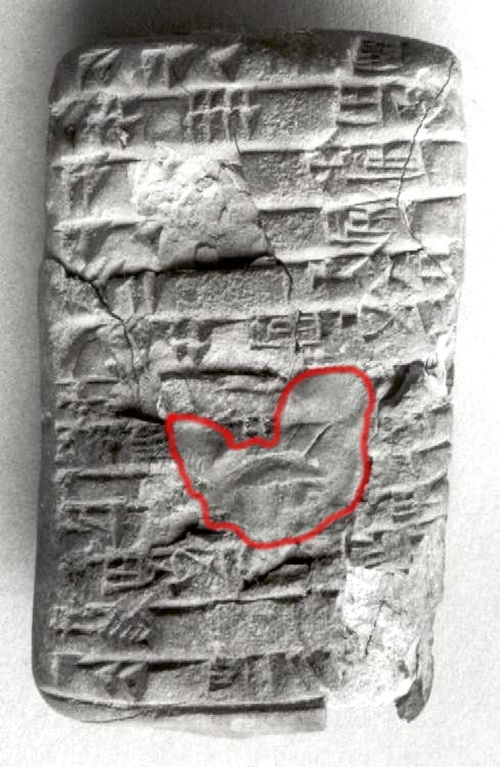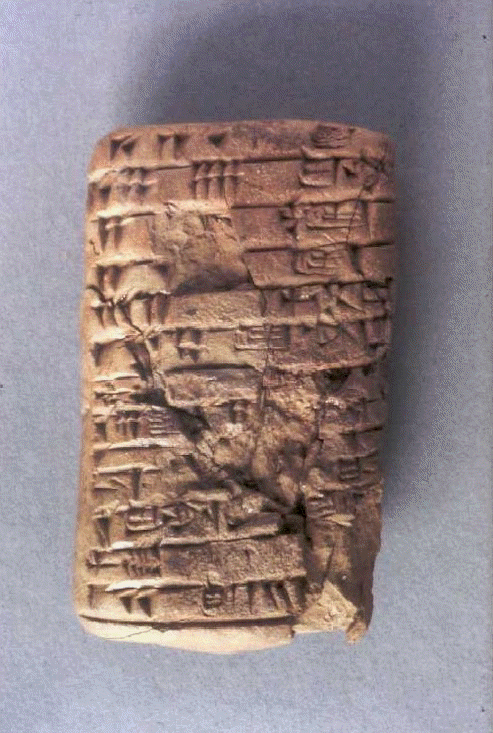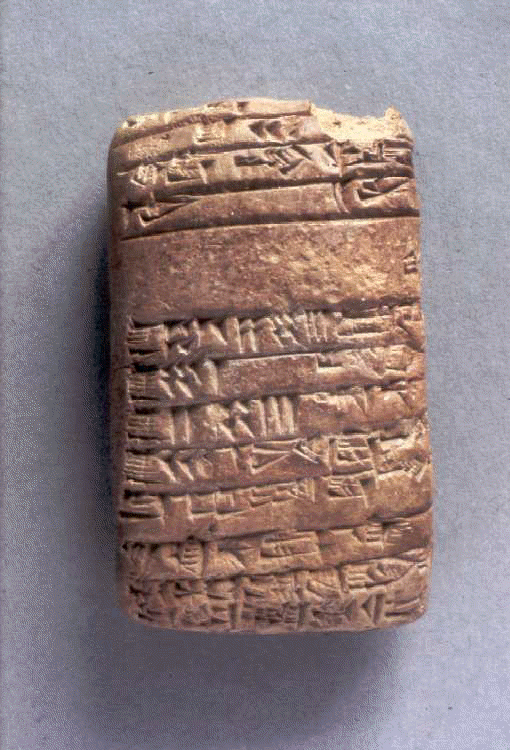cuneiform tablet
origin: Telloh, currently south-east Iraq (at the time Ğirsu, the capital town of the province Lagaš, southern region of the kingdom Ur).
date: 2050 BC

This cuneiform tablet (figures 1, 3a and 3b) is part of the collection of the University of Groningen, the Netherlands. It is published by Dr. N. Veldhuis under number GIS-15.
The tablet was excavated in Telloh, at the time Ğirsu, the capital town of the province Lagaš. It was once aquired by De Liagre Böhl, who tought Assyriology at the University of Groningen in the 1920’s. When he accepted a lectureship in Leiden he left a modest sample of his collection in Groningen.

The text on the tablet is dated to the reign of Amar-Suen, second year, that is about 2050 BC. It comprises an account for a specific year on numbers of livestock (ewes, sheep, male and female goat and lamb) under the care of Šagkugepada at Kinunir: animals present, dead or claimed by civil servants. The total numbers are found in lines 18-20. The result is a shortage of 20 animals (line 21):
- 18: present in total (gub-ba) 2093
- 19: spent in total (zi-ga) 5
- 20: died in total (ri-ri-ga) 183
- 21: shortage (la-NI) of Šagkugepada 20
The text implies that the animals were state property but “leased” by Šakugepada. At the end of the year a specific minimum number of animals was expected. Yet the administrators reckoned with a “normal” loss and births. The possible surplus became property of Šakugepada. He had to make up a deficit. He could substract the demanded animals from the expected total. The desired number of animals is not in the text, it is deduced from the deficit of 20 animals.
condition before treatment
Both sides of the 6 x 4 centimeters sized tablet contain an inscription. Due to accumulation of dust and dirt in the fine incisions the text was rather difficult to read. One side shows cracks on most of the surface; fragments of the text are missing. In the past the center of the cracked side was filled with a plastic material (probably coloured plasticine) to keep fragments together (figure 1). A white deposit was detected on several spots in cracks or in damaged areas. The cracks indicate internal disrupture of the tablet. The white deposit was probably soluble salt, which could explain the forming of cracks. An old photo shows that the condition of the tablet has deterioriated in the past 5 to 7 decades.
Purpose of the treatment would be to :
- stop the deterioration of the tablet,
- remove soluble salts if present,
- clean the tablet in order to improve the reading of the text, in particular the hidden text – if present- under the plastic gapfill, and
- restore the internal coherence.
treatment
Considering the fragile condition of the artefact, it was documented extensively before starting the treatment.
Starting point was the white deposit. Some of it was collected with a scalpel in order to determine its composition. The deposit was soluble in water and with a chloride-ion test the presence of Cl–-ions could be affirmed.
The presence of chloride ions necessitated removal for the conservation of the tablet.


At this stage it was essential to esthablish wether the tablet had been fired or not. Often cuneiform tablets have not been fired and can therefore not be immersed in water for desalination. To test this a small particle from the core, not belonging to the text, was immersed in destilled water. After two days the fragment was still intact and not dissolved. The desalination could start, but not before the plastic gapfilll was removed mechanically using a microscope (10x). Although the partially dessiccated substance could be cut away quite easily, the removal itself caused another problem: the plastic substance held in place a variety of tiny fragments, some of them with text. During the dismantling every fragment was documented on an photo to assist later reconstruction. In total 32 fragments were removed.
The tablet was fixed to a porous support with the side least damaged down. The object was immersed slowly in three hours time because immersion could loosen tiny fragments. The 32 previously removed fragments were desalinated separately. The desalination of the tablet took about 5 months, untill in the water no chloride ions were detectable anymore.
After the treatment the tablet was allowed to dry thoroughly for a week. The next step was impregnation with a reversible restoration adhesive dilluted in a solvent (10% Paraloid B72 in acetone) to stabilize the object. Again the immersion was was carried out very slowly to prevent disruption of tiny fragments. The tablet has been immersed for 7 hours of which one hour under partial vacuum to obtain a thorough impregnation. The 32 previously removed framents were treated separately. Due to impregnation the tablet slightly darkened. This was considered acceptable in the light of the fragile condition and the required manageability. Moreover the tablet in the first place contains historical information, secondly esthetical considerations are of concern. After impregnation local concentrations of consolidant created an unsightly surface. These areas were treated individually with a solvent to aquire a uniform silky matted surface. Subsequently the 32 fragments were refitted with Paraloid B72. After treatment the tablet was documented agian. Now it is kept under controlled conditions.
conclusion
Due to treatment the manageability is improved and the tablet can be studied now. The cleaning of incisions and the removal of the plastic material contribute to the readability of the text. Due to this a fragment of a name could be desciphered and the tablet became comparable to similar tablets. Finally the cuneiform tablet was located chronologically and geographically. Figures 1 and 2 show the tablet after treatment..
further reading
- Veldhuis, N.; Cuneiform Tablets at the Groningen Institute for Semitics, Zeitschrift für Assyriologie, band 93 (2003)
- Walker, C.B.F.; Cuneiform, British Museum, London, 1987 [over spijkerschrift]
- Acta Sumerologica, deel 8 (1986), 133-217 (Snell: the Rams of Lagash) [over dergelijke teksten in het algemeen]
- Buys, S. & V. Oakley; The conservation and restoration of ceramics; Oxford, 1993
